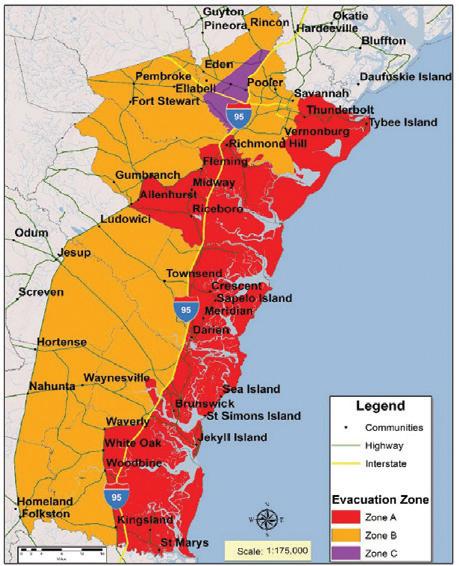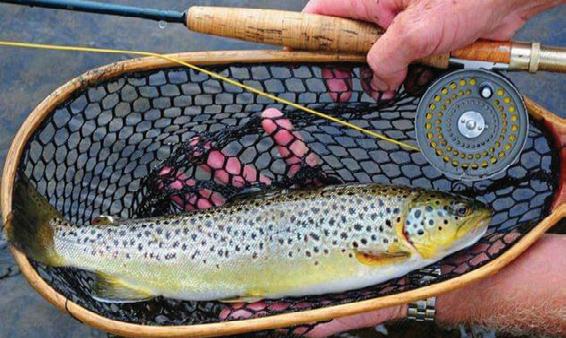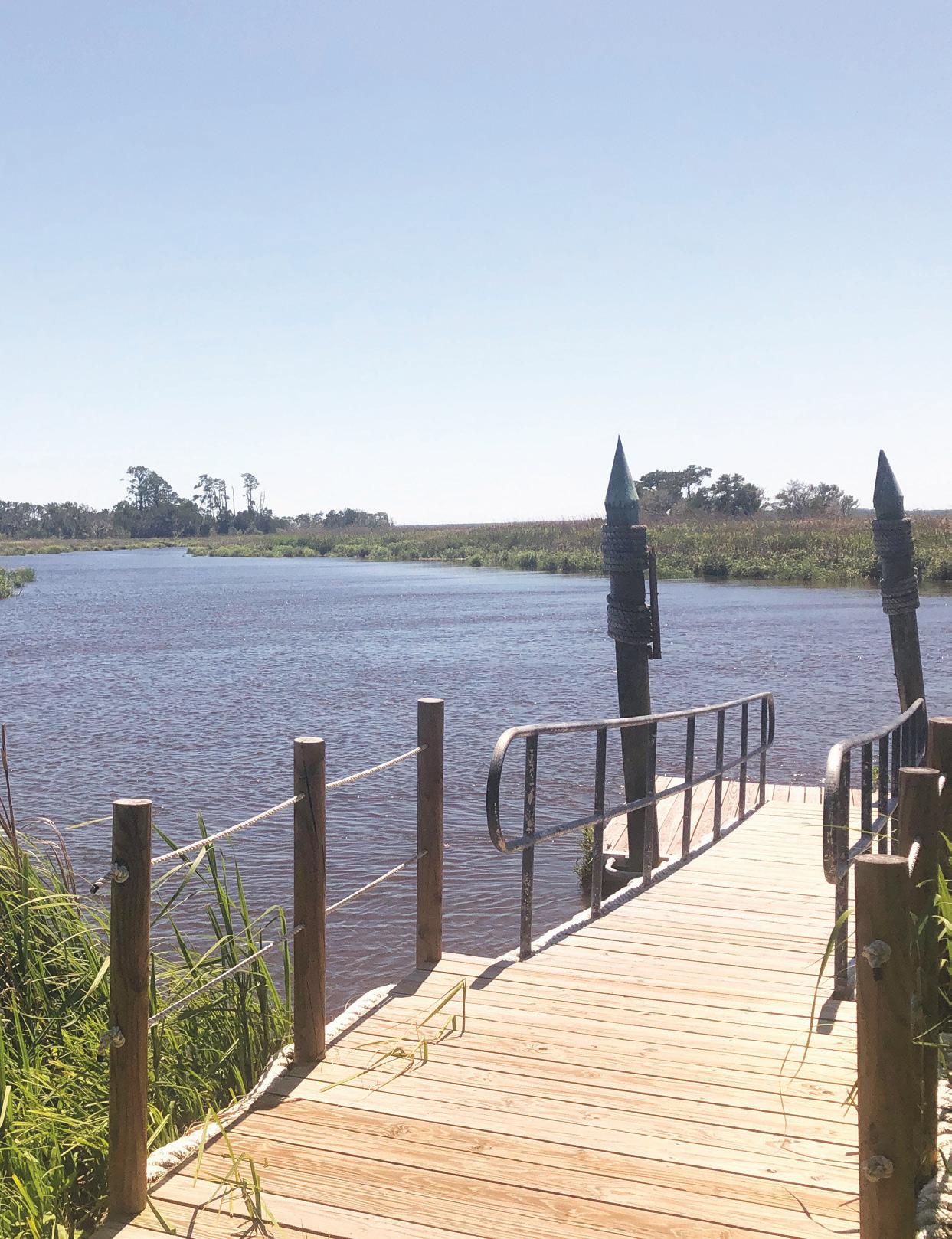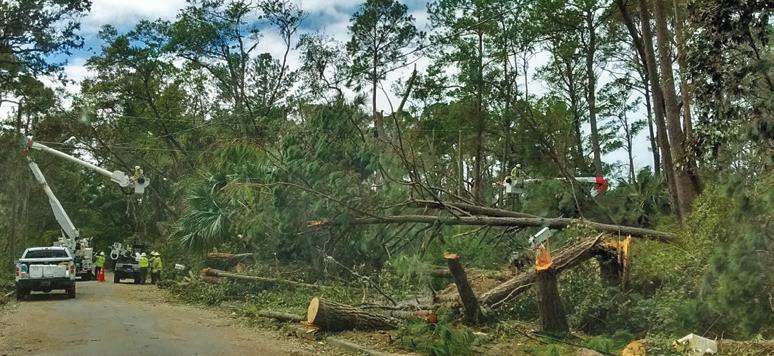
23 minute read
2020 Hurricane Season
By Amy Thurman
Another hurricane season has begun, and all the major forecasting agencies are predicting more activity than average this year. Annual season averages are 12 named storms, six hurricanes and three major hurricanes, while the prediction ranges for 2020 are 18 to 22 named storms, 6 to 11 hurricanes, and 3 – 6 major hurricanes. The probability of at least one major hurricane hitting the East Coast this season is 46%. The average probability is 31%. Though as anyone who’s been through a major storm can attest, it only takes one hurricane to make it a bad hurricane season.
Advertisement
Looking back over the past five hurricane seasons is interesting. While not a sufficient time span to be considered any sort of scientific model, there are still points of significance. (For the sake of discussion, we’re only looking at 2015 to present.)
Looking at the forecasted numbers vs. what actually happened each year shows that actual storms landed at the higher end of the prediction range each year, with the exception of 2019, which exceeded the predicted range. A range of 9-16 named storms were predicted by the three forecasting agencies we follow, yet there were 18 named storms in 2019.
Pre-season storms (prior to June 1) aren’t very common, but there has been at least one pre-season storm each of the past five years, and in 2016, the year of TS Hermine and Hurricane Matthew, there were three named storms before the start of the season – Alex, Bonnie and Colin. Three named storms prior to the start of this year’s season does not mean we’re in for a season similar to 2016, but it does bring an eerie sense of déjà vu. 2015 was the last year Georgia saw no hurricane activity at all. In 2016, five named storms passed through or came near the Georgia/Carolina coastal area: Bonnie, Colin, Hermine, Julia and Matthew. Hermine, although only a tropical storm by the time it reached our area and was inland rather than directly over the coastal region of Georgia, did significant damage. It was overshadowed by far greater damage from Hurricane Matthew only a month later.
In 2017 Irma was predicted to follow Matthew’s path but tracked further west with each passing day. We still saw significant damage from tropical storm-force winds, rain and flooding in the coastal area. 2018 saw threats from Michael (in Ga.) and Florence (in S.C.), though they skirted around our sections of the coast, they both still did heavy damage in other areas of each state.
Dorian was the biggest threat of 2019, after stalling over the Bahamas it tracked along the coasts of Florida, Georgia and the Carolinas. It sustained hurricane strength throughout, though was far enough offshore in our area that we didn’t see the widespread damage we saw with Matthew. North Carolina was not as lucky.
We don’t know what 2020 will hold for our coastal region, but now is the time to start preparing for whatever may come. Here are some tips to get you started. Don’t put it off until a storm has been named – we’ve all seen what last minute runs on the stores can do to the supply chain. Start now, if you haven’t already.
The Southern Tides full hurricane guide can be found on our website and downloaded or printed. www.southerntidesmagazine.com/hurricane.
All information found herein are suggested guidelines only.
Named Hurricanes Major Hurricanes NOAA 13-19 6-10 3-6
2020 Forecast CSU NCSU 19 18-22 9 8-11 4 3-5 Actual 2019 Forecast vs. Actual NOAA CSU NCSU Actual 9-15 14 13-16 18 4-8 6 5-7 6 2-4 2 2-3 3 2018 Forecast vs. Actual NOAA CSU NCSU Actual 10-16 13 14-18 15 5-9 6 7-11 8 1-4 2 3-5 2
Named Storms Hurricanes Major Hurricanes 2017 Forecast vs. Actual NOAA CSU NCSU Actual 11-17 13 11-15 17 5-9 6 4-6 10 2-4 2 1-3 6 2016 Forecast vs. Actual NOAA CSU NCSU Actual 10-16 12 15-18 15 4-8 5 8-11 7 1-4 2 3-5 4 2015 Forecast vs. Actual NOAA CSU NCSU Actual 6-11 7 4-6 11 3-6 3 1-3 4 0-2 1 1 2
Chart Explanations: CSU - Colorado State University's Tropical Weather department; NCSU - North Carolina State University; Major hurricanes = Category 3 or higher.
Arthur Bertha Cristobal Dolly Edouard Fay Gonzalo
Hanna Isaias Josephine Kyle Laura Marco Nana Omar Paulette Rene Sally Teddy Vicky Wilfred
If more than 21 named storms occur in the season, the Greek Alphabet will be used.
Ga. Evacuation Zones
• Remember that even tropical storms can do serious damage. • Leave prior to an evacuation order if at all possible. • If you live in a mobile home, evacuate, no matter what. • Never drive on flooded roads or walk through flood water. • Keep a close eye out for downed power lines at all times. • Stay away from windows and doors when wind speeds increase. • Do not use candles or other sources of open flame for light when the power is out. • Discard any refrigerated food that is questionable after a power outage; assume all food touched by flood waters is contaminated and discard it. • Don’t allow your pets to eat or drink anything found outside after a storm. • Do not drink tap water during or after a storm until water restrictions have been lifted. • Do not attempt to re-enter an evacuation zone until restrictions have been lifted. • Attempt to help anyone in need, but do not move injured persons. • Monitor local weather for tornado warnings and storm updates. • Do not operate a generator indoors or near open windows and doors. • Do not attempt to connect a generator directly to your electrical panel. • Turn off items that draw a lot of power (such as air conditioners) before power goes out. • Use caution when operating a chain saw, hand saw, or ax to remove debris, and when climing ladders. • Do not use a grill indoors. • Stay hydrated and take care not to get overheated during clean-up. • Wear gloves, boots, safety glasses and sunscreen during clean-up.
Coastal Georgia now has three evacuation zones, A, B and C. Most of Zone A is east of I-95. Although the zones were largely determined by flood potential, other factors were used as well. If an evacuation order is issued for your zone, it's imperative that you leave.

Evacuation Routes
In Georgia
Visit www.dot.ga.gov/DS/Emergency/Hurricane. The map near the bottom of the page shows multiple evacuation routes.
In Beaufort, SC
Visit https://bit.ly/beaufort_evac for your route.
Where Will You Go?
Determine your options now in case you need to go later.
Friends or Family Outside the Coastal Area
Contact them now and make certain they’ll be able to open their home to you on short notice. Remember, you don't have to go far, just outside potential evacuation zones and the storm's path. Shorter evacuation routes means less time on the road and less traffic.
An Inland Hotel
Start with a list of three hotels near evacuation routes, and have a list as well of three or more hotels a good distance off evacuation routes. Choose hotels that will fit your budget and begin putting aside funds now for that possibility. If you have pets, visit www.pet-friendly-hotels.net, which has a map search feature.
Airbnb
www.airbnb.com is a home-sharing community through which individuals can offer space in their home to travelers for a fee, similar to the way a regular B & B inn would work. In the event of a disaster, Airbnb will activate their disaster response program and contact hosts both in and near the affected area to see if they’d like to offer their space at no charge, to evacuees or disaster workers. Anyone can register and offer their home or register and request lodging. Visit www.airbnb.com/openhomes/disaster-relief to learn more about the program.
Red Cross Shelters
Shelters will be opened along evacuation routes, typically four hours after an evacuation notice has been issued. This should be considered a last resort. If you are unable to evacuate on your own and need assistance, please register NOW with the Georgia Hurricane Registry: www.gachd.org/emergency-prep/residents_
with_special_needs_1/ or call (833) 243-7344
If you simply can’t evacuate, invest in a generator now and learn to prepare your family and home to withstand a storm. Emergency Services will not be available - you will be on your own. For more on sheltering in place, see our full guide at www. southerntidesmagazine.com/hurricane.
Plan Now!
SouthernTidesMagazine.com/hurricane
Taking care of these tasks now can save time and added expense in the days before a storm. ☐ Learn the elevation of your home Flooding is a major destructive force during hurricanes. Visit viewer.nationalmap.gov/theme/elevation/ to find your home's elevation. Make plans to secure your home and property. ☐ Seal any leaks in your roof ☐ Trim dead limbs and shrubbery Continue to monitor throughout season, but do not trim once a storm is imminent unless you have a way to dispose of the debris – loose piles of dead limbs and yard waste can cause damage during heavy winds. ☐ Learn how to turn off your utilities ☐ Purchase materials to cover your windows Store in a dry location (storm shutters or ½-inch plywood and 2 ½-inch screws). Mark each board as to what window it goes to, pre-drill holes for screws every 18 inches. ☐ Consider installing roof tie-down straps ☐ Service your generator (or purchase one) Even if you evacuate, power may still be out for some time after you’ve returned home. Have a plan for what appliances will be powered and how cords will be run (do not wire generator directly into electrical panel); use caution to avoid creating a fire hazard. Store a copy of your generator manual with your insurance documents. Begin stocking up on ethanol-free fuel (and oil, if needed). Start and run your generator quarterly. See Generator Operation & Safety in our hurricane guide SouthernTidesMagazine.com/ hurricane. ☐Create a home inventory Make a list of your home’s contents and take photos of valuables, including yard and garage (update as you make new purchases). Store list and images with your homeowners or renter’s insurance policy. ☐Review your homeowners or renters insurance Talk with your insurance agent to understand your insurance coverage levels and deductibles; ask if your deductible can increase due to hurricane damage and ask about roof replacement as some policies have special stipulations. Purchase flood insurance. ☐ Plan where you’ll park/store vehicles (including boat) ☐ Plan where you’ll store patio furniture and other outdoor items ☐ Have vehicle serviced and oil changed, inspect spare tire ☐ Plan what you’ll do with food in your refrigerator and freezer
More Pre-Planning
☐ Build an emergency kit Or check your existing kit for any expired items or things that need to be rotated out. ☐ Gather your important documents This is more time consuming than you might think. ☐ Plan for important family keepsakes/heirlooms There simply isn’t room to take everything in your home when you evacuate. Plan how you’ll handle items like photo albums, antiques, and other valuables you can’t easily replace, such as placing them on the top shelf of a closet or other elevated location, in case of flooding. ☐ Begin saving water storage containers Two-liter soda bottles are easy to sanitize (unlike milk jugs). Clean and allow to air dry, then store in an out of the way place (under your bed, for example). After a storm, stored water can be used to wash hands, do dishes, and light cleaning. ☐ Plan for your pets Make sure their shots are current (pet shelters won’t accept animals without proof of vaccinations). Make sure you have all needed equipment (travel crates, collars with tags, leashes, etc.). Take a current photo of your pet for identification purposes. (See Planning for your Pets) ☐ Assist others with their plans Check with friends, family and neighbors and offer to help them formulate a plan. ☐ Water At least a three-day supply (preferably seven); one gallon, per person, per day. Don’t forget drinking water for your pets. ☐ Food At least three, preferably seven days of food for each person in your household. (Check out our guide online for food suggestions.) ☐ Manual can opener with bottle opener ☐ Disposable kitchenware Paper/plastic items (plates, cups, bowls, utensils, paper towels), sealable plastic bags, foil, and disposiable aluminum pans for cooking on the grill, in the event the water is off or use is restricted and dishes can't be safely washed. ☐ Bleach (unscented) and a medicine dropper To disinfect questionable water, add six drops of bleach per gallon of water, stir, then let stand 30 minutes. (Still may not be safe for drinking!) ☐ Pillow and blanket or sleeping bag, one per person ☐ Change of clothes and sturdy, comfortable shoes ☐ Rain gear ☐ First aid kit and first aid manual ☐ Prescription medications (at least a two-week supply) ☐ Toiletries for each person ☐ Hand sanitizer and wipes ☐ Toilet paper ☐ Sunscreen and insect repellent ☐ Flashlights and extra batteries ☐ Battery operated or hand-crank radio (VHF radio is great!) ☐ Battery chargers and cords for cell phones, for car and house ☐ Pet supplies (See Pet Planning) ☐ Tool kit Standard hand tools including a hammer, nails, screwdrivers, saw, hatchet, crowbar, multi-tool, rope, tarp, duct tape, and heavy gloves, at a minimum. ☐ Vehicle supplies Five-gallon gas can, extra oil, jumper cables, jack, tire iron, spare tire, map or road atlas (in case of lost signal), spare keys, Fix-a-flat, white distress flag. ☐ Plastic trash bags (and ties if needed) ☐ Charcoal or propane for your grill ☐ Fire extinguisher ☐ Matches in a waterproof container and disposable lighters ☐ Entertainment Books, cards, board games, things to alleviate boredom, and quiet toys to keep children occupied and distracted. ☐ Identification and proof of residence ☐ Copies of important documents ☐ Specialty items Any items needed for infants, small children, medical needs, or items such as contact lens or hearing aid batteries.
Packing & Storage Tips
• Plastic storage containers stack easily and can be sealed with duct tape if at risk of getting wet. • Provide each family member with an overnight soft-sided duffle for their clothing, toiletries and entertainment items. Hard-sided luggage is harder to squeeze into a tightly packed vehicle. • Group like items for ease of finding what you need, such as nonperishable foods with disposable kitchenware. • All food items should be rotated out to avoid spoilage waste. Use and replace before expiration.
• Gather all applicable documents for all family members • Scan and save to a secure online storage site • Make paper copies and a flash drive to keep with you (consider making a household binder for storage and easy access of all documents) • Store originals in a safe location, such as a safe deposit box or fire safe ☐ Identification Driver’s license, employee ID, military ID, passport, birth certificate, social security card, weapons permits, or any other official identification. ☐ Medical Information List of healthcare providers and contact information, pharmacy contacts, medications list, immunization records (for pets, too), eyeglass/contact prescriptions, and health insurance information. ☐ Residence/Property Information Property deed, lease or rental agreement, list of all utility companies with contact information and account numbers, property appraisals, household inventory with photos, photos of the exterior of your home prior to the storm, and homeowners or rental insurance policies. ☐ Legal Documents Marriage certificate, military documents (including DD-214), current will, advance directive or living will, power of attorney forms, vehicle titles, adoption paperwork, any other legal contracts. ☐ Financial Records Recent bank statements with account and routing numbers, checkbooks and savings books, stocks, bonds, a list of all personal bills with contact information and account numbers, tax returns, any other financial statements or records. ☐ Additional Insurance Policies Life insurance, boat coverage, any other insurance policies you may hold, account numbers, and agent contact information.
Plan for Your Pets There are several evacuation options for pet owners (service animals are not restricted in shelters or most hotels): • Family or friends who can accommodate your pets. • Pet-friendly hotels – www.pet-friendly-hotels.net is a great site that allows you to search by state, then by city, then using a map so you can search near your evacuation route. • Boarding facilities may be available in the area you plan to evacuate to. Research options in that area and be sure you can visit your pets while they’re boarded. • Pet shelters will be established near Red Cross evacuation shelters and will be publicized when evacuation orders are issued. ☐ Locate a vet in the area you’ll be evacuating to, in case of emergency while you’re away from home. ☐ Get a copy of your pet's current vaccinations. ☐ Have a current identification tag made for your pet’s collar or harness, with your pet’s name, any important facts (blind, deaf, etc.), your name, and contact phone numbers. Also keep a record of any micro-chip information, shot records, and a current photo of your pet with your important documents. When gathering your own hurricane supplies, include the following for your pets: ☐ Food and water for at least a week, preferably two, and their dishes ☐ Any medications, flea prevention, or vitamins ☐ Treats, toys and blankets for comfort ☐ Collars or harnesses and leashes ☐ Grooming needs such as brushes and shampoo ☐ Litter, litter box, and waste disposal bags (for at least a week) ☐ A crate or carrier large enough for your pet to stand up and turn around in, and a dog bed ☐ A pet first aid kit (talk with your vet about what might be needed) ☐ Extra towels Do your best to keep your pet calm during evacuation preparations, travel, and your stay in an unfamiliar location. Treats and toys will help. Some animals sense changes in the barometric pressure and/or are afraid of severe weather. If this is the case, talk with your vet about options, including a mild sedative or herbal remedy if their fear is extreme. WHEN A STORM HAS BEEN NAMED ☐ Monitor hurricane updates at the National Hurricane Center (NHC): www.nhc.noaa.gov. ☐ Review all hurricane plans and finalize any last minute details you might have missed in early planning. ☐ Double check your hurricane kit and pick up anything you still need. ☐ Touch base with the family/friends you’ll be staying with to let them know a potential arrival date/time. ☐ Withdraw cash – ATMs and card processing machines will be down when power is out. ☐ Check oil and tires, wiper blades, and fill gas tank on all vehicles that will be used to evacuate. ☐ Clean gutters, check trees for dead limbs and remove (if they can be disposed of prior to storm). ☐ Double check flashlights to make sure all have working batteries. ☐ Start and run generator to make sure all is in good working order, refill gas cans with ethanol-free fuel as needed. ☐ Check to be sure bathtubs hold water without leaking. If they leak, dry area thoroughly and duct tape liberally around plug to be sure you can seal tubs prior to your departure. Water may not be on when you return. ☐ Gather your evacuation list items and put them in one spot for easy loading. ☐ Move your boat and other recreational vehicles to the safe location you determined prior to hurricane season.
WHEN A HURRICANE WATCH HAS BEEN ISSUED ☐ Continue to monitor the NHC for storm updates, also pay attention to local news broadcasts for evacuation information. ☐ Confirm your evacuation destination if staying with family/friends, or make hotel or Airbnb reservations. ☐ Charge all electronics and use only when necessary. ☐ Fill sandbags and put in place if flooding is a risk. ☐ Board up windows with pre-drilled boards. ☐ If the storm shows no sign of turning away, begin evacuation as soon as possible, even if official order hasn’t been given, to minimize traffic congestion.
WHEN A HURRICANE WARNING HAS BEEN ISSUED ☐ Continue to monitor the NHC for storm updates, also pay attention to local news broadcasts for evacuation information. ☐ Move all outdoor items to a secure location in a garage or basement. ☐ Fill water containers and bathtubs; put a manageable bucket in each bathroom in case water is not restored when you return home. ☐ Charge all electronics. ☐ Remove all food from refrigerator and freezer to avoid spoilage when power is lost. ☐ Load vehicle with hurricane kit; keep a cooler handy with water and snacks for the drive. ☐ Move valuables and family heirlooms according to your plan. ☐ Unplug household appliances and electronics. ☐ Disconnect or turn off utilities if possible. ☐ Make sure all pets are loaded in vehicle, then lock house behind you.
Weather Monitoring Resources
National Hurricane Center: www.nhc.noaa.gov Weather Underground: www.wunderground.com/hurricane Weather Channel: weather.com/storms/hurricane-central
Also monitor your local TV and radio news for local flood alerts, rain and wind advisories, and evacuation information.
Any damage caused by your boat is your responsibility, to include hitting other boats, damage to docks, fuel spill clean-up, or boats that sink and must be salvaged. It’s important to understand your insurance coverage, secure your boat properly, and take every precaution to prevent damage to other property. As with home preparations, many tasks can be completed now to save time and expense later in the season.
Do Now
☐ Review your boat insurance policy and revise if necessary Consider a rider to your policy that covers salvage, recovery and environmental impact. Most standard policies do not include this. If you aren’t certain your policy is sufficient, BoatU.S. will review it and advise you of discrepancies, at no charge. ☐ Update your contact information with your marina Make certain they have your current home, work and cell phone numbers, email address, and emergency contacts. Update immediately if your information changes during the season. ☐ Determine where you'll move your boat • Talk with your marina about their hurricane plan. • Dry storage and trailered boats should be moved inland to a secure location. Boats kept in the water can be hauled and moved inland, or moved to a hurricane hole. If you opt to go this route, make certain you know how long it will take to move your boat and secure it - and how to do so properly. ☐ Inspect your vessel now Make any structural repairs that may be further compromised during severe weather, check all cleats for stability and repair as needed. ☐ Inspect your equipment Make sure you have a sufficient number of anchors, extra lines, fenders, and chafe protection. ☐ Make a list of items to be removed before a storm Loose or unsecured items should be removed prior to a storm. Making a list now will prevent confusion or missed items at the last minute. Fishing gear, outriggers, sails, cushions, coolers, awnings or biminis, electronics and other valuables, and any items below deck that could come loose and cause damage. Also list anything that will need to be lashed down or otherwise secured. ☐ Put together a boat information packet Include your boat insurance policy, boat registration, photos of the boat from multiple angles, a gear inventory, your marina dockage/storage agreement, towing contract, and key phone numbers, such as your insurance agent, towing company, local Coast Guard station, and marina. Scan and save all information with your other important papers and make a print copy to keep on the boat in a dry locker. ☐ During the season, keep batteries charged, fuel topped off, and start your motor regularly so there are no last minute surprises.
When a Storm is Approaching
Take these steps when a storm is in the Atlantic or the Gulf of Mexico and a watch seems imminent - do not wait until a watch has been issued. ☐ Secure your boat Using your list, remove all loose gear and store at home, lash down anything else that may come loose and cause damage during heavy winds and seas. ☐ Initiate your boat hurricane plan If you live aboard or keep your boat docked at a marina, act now on your plan to either haul your boat or move it to a hurricane hole and secure it. For more on this, visit: http://www.boatus.com/magazine/archives/hurricane-hole. asp NEVER stay aboard during a tropical storm or hurricane. ☐ Contact your marina now If you store your boat at a marina, contact them now and ask to be placed on their haulout schedule or to be lifted onto your trailer. As soon as that takes place, move your boat. ☐ Secure your boat against water damage Remove cowls and covering any openings (such as where electronics are housed) with duct tape. Tape around hatches, lockers, and ports. If storing out of the water, remove drain plug. If storing in water, be certain all drains are clear of debris and secure any items that might slide and block drains.
Reducing Risk at the Dock
If you must keep your boat docked, understand that you will be responsible for any damages caused by your vessel if it breaks free, rams or rubs nearby boats, or damages the dock – which can be extensive. Also note that most pilings in our area are not of sufficient height to withstand the full potential storm surge for our area. During Hurricane Matthew, many area docks came close to the tops of pilings. A Category 2 or higher storm, during high tide, could cause many area docks to lift completely off the pilings and float away, with your boat attached. Please take the following precautions: ☐ Make sure all cleats (boat and dock) are firmly bolted in place with no play. ☐ Check all lines for wear spots that may weaken and break during heavy wind and rough seas and replace them. Make sure all fenders are properly inflated and all chafing gear is secured. ☐ Allow sufficient distance between your boat and any boats around it. ☐ Be certain your knots are tied properly and securely. ☐ Proper line placement guides (along with other helpful tips) here: www. boatus.com/hurricanes/HurricaneWarning.pdf. NOTE: Lines tied too tightly can cause as much damage as those tied too loosely. Research the proper way to secure a boat (with more focus on spring lines).
After the Storm • If you store your boat in a marina, contact them by phone or email before attempting to return your boat or go check on it. They may be contending with damage and need to keep the area clear. Allow them to return to normal operations rather than adding to the chaos. • If you stored your boat inland, wait until travel is unrestricted and evacuation areas are fully open before attempting to travel to your boat or return it to your home or marina. • If you secured your boat in a hurricane hole, use caution when attempting to reach it – water bottoms may have shifted, floating and underwater debris may present unseen hazards, and watch for downed power lines near small creeks or damaged bridges. Pay attention to small craft advisories and check with the Coast Guard or your area marine patrol to be sure the area is safe. • If your boat has taken on water, do not attempt to board and salvage the boat yourself. Secure it without boarding if possible and contact a local salvage or dive company that specializes in safely refloating vessels. • For more information visit: www.boatus.com/hurricanes/after.asp










